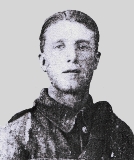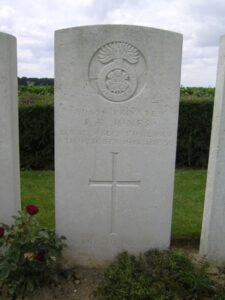Bryngwenith Chapel is situated two miles north of Henllan, between Llangynllo and Llandyfriog. Inside the chapel is a marble memorial plaque, which commemorates the members who fell during the Great War. The photograph of the plaque was kindly supplied by Raymond Jones.
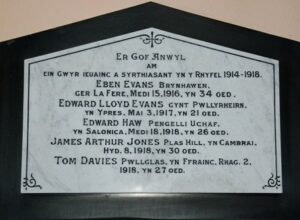
The Great War, 1914-1918
Tom Davies, Private, 201674, Welsh Regiment. Tom was the son of William and Sarah Davies, of Pwllglas, Llandyfriog. He served during the war with the 1st/6th Battalion, Welsh Regiment, which was the Pioneer Battalion to the 1st Division. The Division had been one of the first to arrive in France, fighting at the retreat from Mons to the Marne. They then fought at the Aisne, and at Chivy, before being moved north, and fought at the First Battle of Ypres. The following year saw them in action at the Battle of Aubers, and the Battle of Loos. During 1916 they fought during the Battle of the Somme. They followed the German retreat to the Hindenburg Line in early 1917, and later that year during the Second Battle of Passchendaele. After spending another Winter in Flanders, they were near Estaires when the German Spring Offensive caught them, before being moved South to Arras, fighting at the Battle of Drocourt-Queant, and at the Battle of Épehy. The Division pushed on towards the St. Quentin Canal, and after crossing the Hindenburg Line fought at the Battles of Beaurevoir, the Selle and the Sambre. Tom survived the war, but became ill and died on 2 December 1918, aged 27. He is buried at Premont British Cemetery, France.
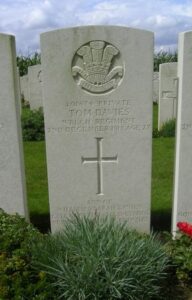
Eben Evans, Private, 533050, London Regiment. Eben was the Son of the Reverend Daniel Evans and Mrs. Evans, of Brynhawen, Henllan, and was the Husband of Juliette Marie Evans, of 326, Goldhawk Road, Shepherd’s Bush, London. He served with the 1/15th Battalion (Civil Service Rifles), London Regiment, which was attached to 140 Brigade, 47th (2nd London) Division. The Division moved to France in March 1915, and fought at the Battle of Aubers, and the Battle of Festubert during May 1915 and in September fought at the Battle of Loos, and subsequent Action of Hohenzollern Redoubt. They were north of Arras when the Germans attacked Vimy Ridge, and then moved south to the Somme, where they fought at the Battle of Flers-Courcelette, and then at the Battle of Le Transloy. Eben was killed in action here on 15 September 1916. He was 34 years old, and is commemorated on the Thiepval Memorial, France.
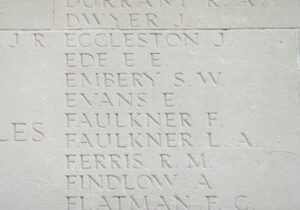
Edward Lloyd Evans, Private, 13059, Welsh Regiment. Edward was the son of Edward and Sarah Ann Evans, of Llandyfriog, Newcastle Emlyn. He enlisted at Carmarthen into the 9th Battalion, Welsh Regiment. The Battalion was attached to 58 Brigade, 19th (Western) Division, which crossed to France during July 1915, and fought during the opening attack of the Battle of Loos on 25 September. The Division suffered heavy casualties at Loos, and Edward was one of many men drafted into the 9th Welsh to rebuild its strength. During 1916 the division moved to the Somme, and took part in the second wave of the attack on Ovillers-La Boiselle on 1 July 1916 capturing the village at heavy cost. It remained on the Somme, and fought through the Somme Battles of Pozieres and the Ancre in 1916. During 1917 the division moved to positions south of Ypres, and this is where Edward was killed in action on 3 May 1917. He was just 22 years old, and is buried at Vlamertinghe Military Cemetery, Belgium.
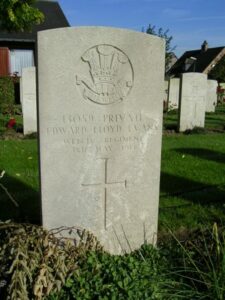
Edward Joseph John Haw, Private, 14261, Royal Welsh Fusiliers. Edward was born on 19 March 1892, the son of Joseph and Martha Haw, of London. He lived and worked at Pengelli Uchaf prior to the war, and enlisted at Carmarthen into the 11th Battalion, Royal Welsh Fusiliers, which was attached to 67 Brigade, 22nd Division. Edward landed in France with the battalion on 5 September 1915, but the division only spent a short period on the Western Front before embarking at Marseilles for Salonika on 27 October 1915. It remained there for the duration of the Salonika campaign, taking part in several large scale pitched battles. Edward was killed during the Battle of Doiran on 18 September 1918, aged 26. He is buried in Doiran Military Cemetery, Greece.
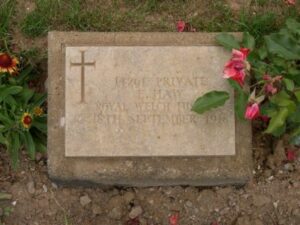
James Arthur Jones, Private, 59656, Royal Welsh Fusiliers. James was the son of Mr. and Mrs. Ben Jones, of Plas Hill Llandyfriog. He worked as a Salesman in London prior to the war, and enlisted at Marylebone into the 13th Battalion, Royal Welsh Fusiliers, who were attached to 113 Brigade, 38th (Welsh) Division. The Division had landed in France during December 1915 and had spent their first winter in the trenches near Armentieres, before taking part in the capture of Mametz Wood in July 1916. James probably joined the battalion after it had been withdrawn from Mametz, via Hebuterne to Ypres. Here they fought at Pilckem and Langemarck, then moved to Armentieres, where they remained from September 1917 until March 1918 when the German Spring Offensive was launched. The British had been over-run on the Somme, and so in April the Division was moved south, taking up positions North of Albert, from where they weathered the storm of the coming months, until the war turned during the Battle of Amiens, on 8 August 1918. The Germans had now lost the upper hand, and the British regained the lost ground on the Somme after an attack which began on 21 August, with the 38th Welsh in the midst of the attack during the Battle of Albert, and then moving east, where they fought at the Battle of Bapaume. Then the move began towards the mighty Hindenburg Line, and the Division carried on with their march east, fighting at the Battle of Havrincourt, and the Battle of Épehy. A short rest period ensued, during which time the Canal du Nord was breached, so opening a passage through the Hindenburg Line. The Division then fought at the Battle of Beaurevoir, and moved up towards Cambrai, where James was killed in action on 8 October 1918. He was 30 years old, and is buried at Moulin-De-Pierre British Cemetery, France.
